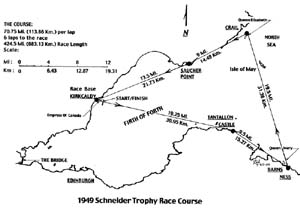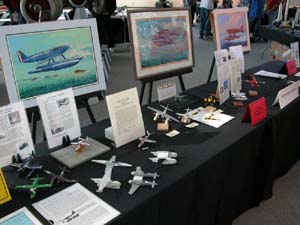THE 1949 SCHNEIDER TROPHY RACE
By
Tim Nelson
Course Map by Jim Schubert
|
|
Introduction
The Schneider Trophy race was one of aviation's premier events during
the period from 1913 to 1931. The trophy, established by the wealthy French
aviation enthusiast Jacques Schneider, promoted the development of 'hydro-aeroplanes'
via racing, and led to dramatic contests between the major aircraft producing
powers. Names such as Deperdussin, Savoia, Curtiss, Macchi, and Supermarine
became synonymous with speed, grace, and power. The Schneider races brought
about many advances in aerodynamic and powerplant design, some of which
bore fruit years later when the participating nations became combatants
in the Second World War.
The United States and Italy both came close to permanently retiring
the Schneider Trophy, by nearly reaching the agreed upon criterion of
winning three consecutive races. The British finally pulled it off in
1931 when no other nation was prepared to compete on the scheduled date;
they sent a Supermarine S.6B aloft and won the race unchallenged. This
achievement, following their wins in 1929 and 1927, secured the Schneider
Trophy permanently for Great Britain.
Post-War Resurrection
Nothing is permanent. In the years following World War Two, the community
of nations sought ways to heal the wounds of the horrific war they had
just experienced. The jet age was dawning, while piston engine technology
was at its zenith. Rocketry was emerging as a technology of great promise.
Rapid strides were being made in speed, altitude, and range capabilities.
What better way to unite the world in the new age of technology than with
sport? What better way to beat swords into ploughshares than to take the
killing machines of the recent conflict and turn them into chariots of
peaceful competition? What more graceful form of aircraft than the seaplane?
Thus was resurrected the Schneider Trophy race.
Great Britain, still stinging from allegations of 'unsporting' behavior
in 1931, and feeling benevolent being among the victorious Allies in the
war, proposed the idea of a renewed Schneider competition in the spring
of 1946. Recognizing the long lead time required for an advanced technological
endeavor of this nature, a committee of participating nations set October
26, 1949 as the date for the great event. As the most recent winner, Great
Britain retained the privilege of selecting the race site, and selected
a course over the Firth of Forth, off Edinburgh, Scotland. The airfaring
nations of the world thus girded their loins for an event of Olympic proportions.
The Course
 The
Edinburgh/Firth of Forth site was chosen to make a clean break from the
previous British-hosted Schneider races in the Portsmouth area. The course
layout gave consideration to the advancements in speed since 1931, the
need for significant support facilities, and the likely tremendous crowds
wishing to see the spectacle. The
Edinburgh/Firth of Forth site was chosen to make a clean break from the
previous British-hosted Schneider races in the Portsmouth area. The course
layout gave consideration to the advancements in speed since 1931, the
need for significant support facilities, and the likely tremendous crowds
wishing to see the spectacle.
The final original Schneider races in 1929 and 1931 took place on courses
of slightly different layout but based on 7 laps of approximately 50 km
each. The 1949 Edinburgh course was lengthened to a 113.86 km triangular
layout, with 6 anti-clockwise laps for a total race distance of approximately
683 km. Altitude during the race was limited to no more than 1000 ft.
Race results, consistent with earlier Schneider tradition, were based
on the minimum time to complete the race distance, not a head to head
competition for position. The course layout required that race designers
consider speed, maneuvering capability, and range. The city of Edinburgh
provided ample harbor facilities for race logistical support, and the
north and south shores of the Firth afforded ample viewing sites for the
throngs. A large area in the middle of the course was set aside for boats.
Both Cunard and Canadian Pacific moored their top ocean liners inside
the main pylons and sold Race Week packages for enthusiasts to enjoy the
proceedings in style.
Unseasonably warm and clear weather set the stage for a spectacular
event.
The Models
 The
1949 Schneider Trophy Race is being commemorated with a model contest
at the IPMS/Seattle Spring Show on April 16, 2005, at the Renton Community
Center in Renton, WA. The purpose of the project is threefold: fun, fun,
and fun. Some of the entries were previewed at the NorthWest Scale Modelers
show at Seattlešs Museum of Flight on February 19 20, 2005. The
1949 Schneider Trophy Race is being commemorated with a model contest
at the IPMS/Seattle Spring Show on April 16, 2005, at the Renton Community
Center in Renton, WA. The purpose of the project is threefold: fun, fun,
and fun. Some of the entries were previewed at the NorthWest Scale Modelers
show at Seattlešs Museum of Flight on February 19 20, 2005.
The 1949 Schneider Trophy Race project has been a chance to be creative,
put the reference materials aside, and have some fun modeling. There has
been much excitement and enthusiasm about it, and we expect to see a large
collection of strange and wondrous 'hydro-aeroplane' models on April 16.
Look for a full report in a future issue of Internet Modeler.
|
|